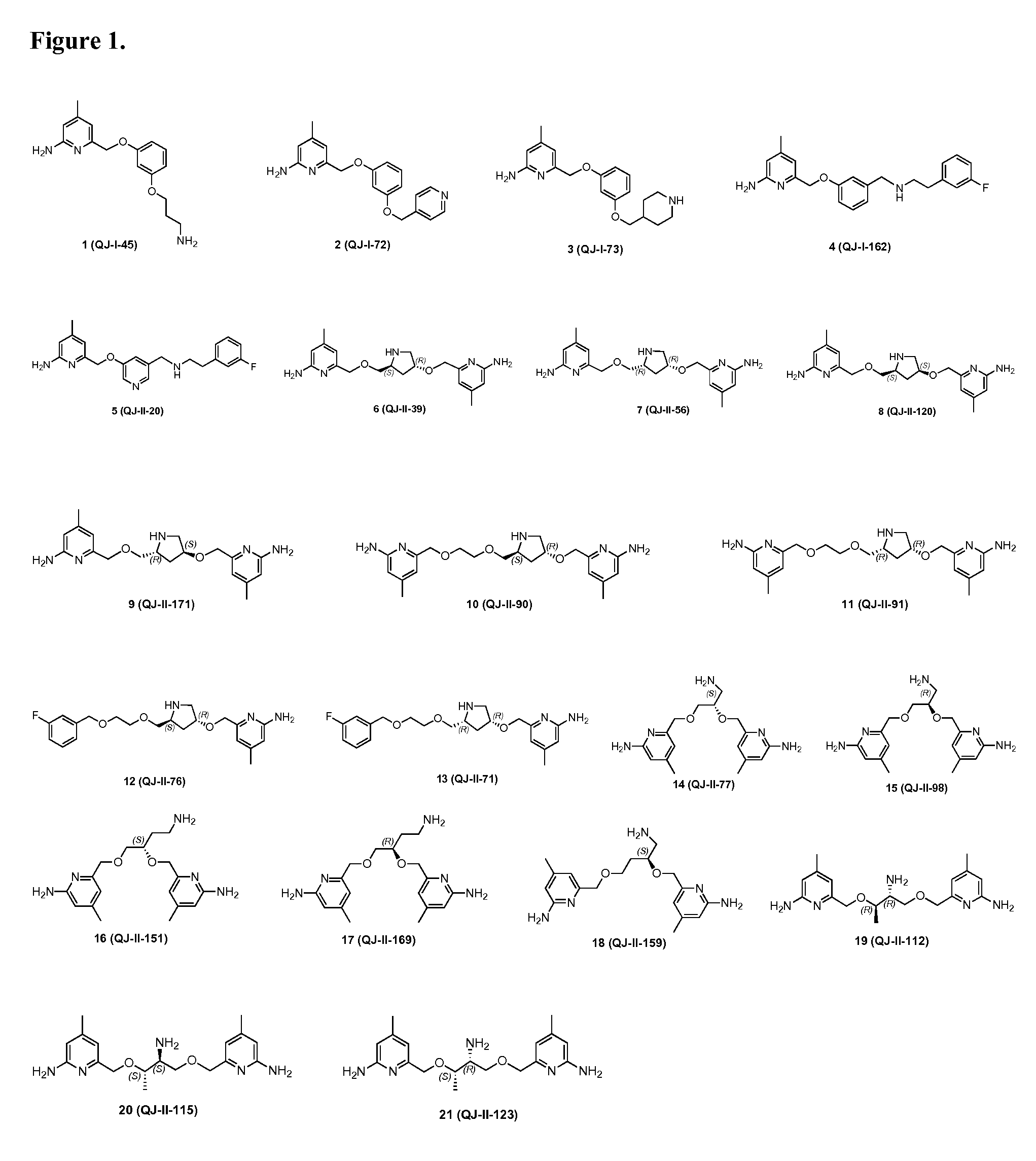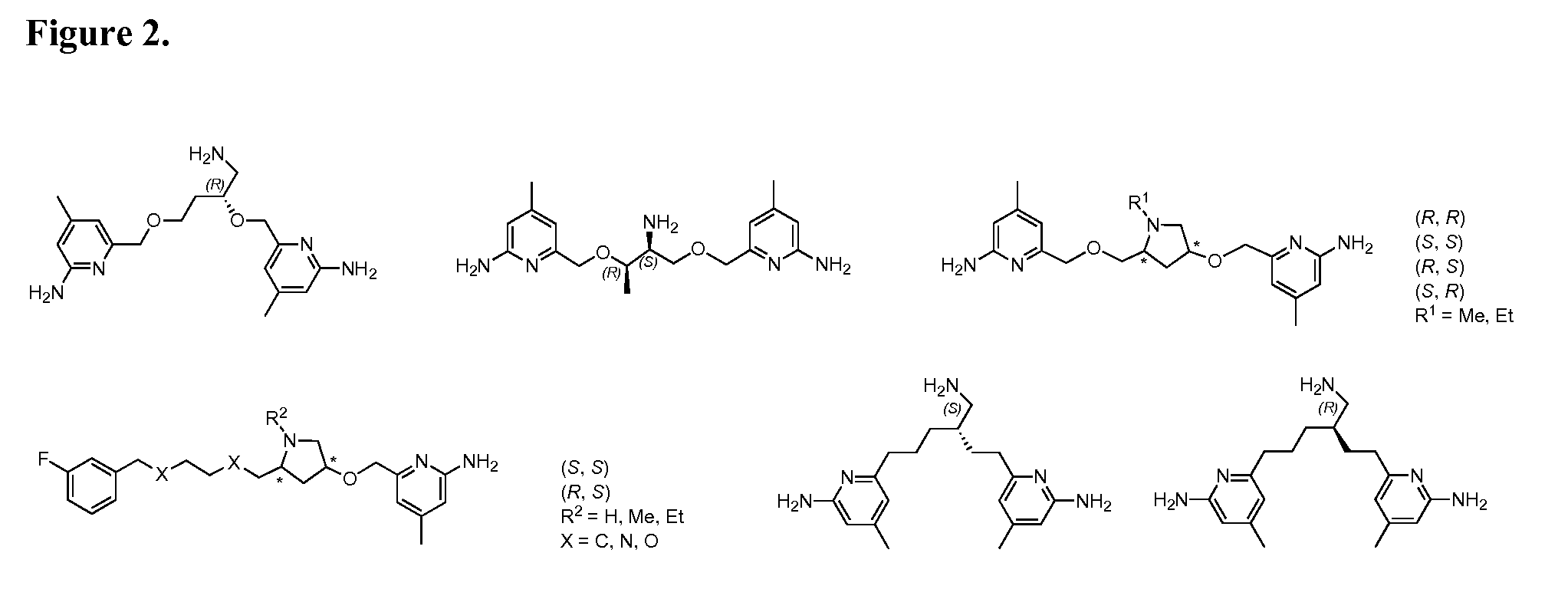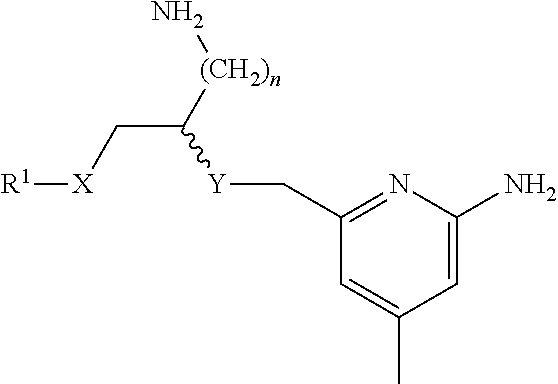2-Aminopyridine-based selective neuronal nitric oxide synthase inhibitors
a nitric oxide technology, applied in the field of 2aminopyridine-based selective neuronal nitric oxide synthase inhibitors, can solve the problems of inhibiting endothelial nitric oxide synthase (enos) and inducible nitric oxide synthase (inos), impeded their therapeutic potential, undesirable, etc., and achieves the effect of promoting selectiv
- Summary
- Abstract
- Description
- Claims
- Application Information
AI Technical Summary
Benefits of technology
Problems solved by technology
Method used
Image
Examples
example 1
[0057]
[0058]Compound 1: M.p. 96-98° C. 1H NMR (500 MHz, CDCl3) δ 1.88-1.94 (m, 2H), 2.23 (s, 3H), 2.90 (t, J=6.5 Hz, 2H), 4.03 (t, J=6.5 Hz, 2H), 4.36 (br, 2H), 4.95 (s, 2H), 6.25 (s, 1H), 6.51 (d, J=7.0 Hz, 1H), 6.56-6.58 (m, 2H), 6.69 (s, 1H), 7.16 (t, J=8.5 Hz, 1H); 13C NMR (125 MHz, CDCl3) δ 21.1, 33.0, 39.3, 65.8, 70.6, 101.7, 106.9, 107.2, 108.0, 112.9, 129.8, 149.7, 155.1, 158.1, 159.8, 160.1 ppm; MS (ESI): 288.3 (M+H)+. HRMS (ESI): calcd. 288.1712. Found: 288.1717.
example 2
[0059]
[0060]Compound 2: M.p. 97-99° C. 1H NMR (500 MHz, CDCl3) δ 2.23 (s, 6H), 4.41 (br, 2H), 4.95 (s, 2H), 5.07 (s, 2H), 6.26 (s, 1H), 6.57 (d, J=7.0 Hz, 1H), 6.61-6.63 (m, 2H), 6.67 (s, 1H), 7.18 (t, J=8.0 Hz, 1H), 7.33 (d, J=5.5 Hz, 2H), 8.60 (d, J=5.5 Hz, 2H); 13C NMR (125 MHz, CDCl3) δ 21.1, 68.1, 70.6, 102.1, 107.4, 107.7, 108.1, 112.9, 130.1, 146.2, 149.7, 150.0, 154.8, 158.2, 159.3, 159.9 ppm; MS (ESI): 322.3 (M+H)+. HRMS (ESI): calcd. 322.1556. Found: 322.1552 (M+H)+.
example 3
[0061]
[0062]Compound 3: white solid 62 mg. 94%. M.p. 103-105° C. 1H NMR (500 MHz, DMSO) δ 1.67-1.76 (m, 4H), 2.13 (s, 3H), 2.42-2.45 (m, 1H), 2.93 (d, J=11.5 Hz, 2H), 3.74 (d, J=6.5 Hz, 2H), 4.83 (s, 2H), 5.82 (s, 2H), 6.18 (s, 1H), 6.44 (s, 1H), 6.51 (t, J=7.5 Hz, 1H), 7.13 (t, J=7.5 Hz, 1H), 8.29 (s, 2H), 13C NMR (125 MHz, CDCl3) δ 20.7, 29.8, 36.0, 45.7, 70.2, 72.5, 101.2, 106.7, 106.8, 107.1, 110.6, 129.8, 147.8, 154.4, 154.5, 159.5, 159.9 ppm; MS (ESI): 328.4 (M+H)+. HRMS (ESI): calcd. 328.2025. Found: 328.2027 (M+H)+.
PUM
| Property | Measurement | Unit |
|---|---|---|
| diastereomers | aaaaa | aaaaa |
| permeability | aaaaa | aaaaa |
| enantiomers | aaaaa | aaaaa |
Abstract
Description
Claims
Application Information
 Login to View More
Login to View More - R&D
- Intellectual Property
- Life Sciences
- Materials
- Tech Scout
- Unparalleled Data Quality
- Higher Quality Content
- 60% Fewer Hallucinations
Browse by: Latest US Patents, China's latest patents, Technical Efficacy Thesaurus, Application Domain, Technology Topic, Popular Technical Reports.
© 2025 PatSnap. All rights reserved.Legal|Privacy policy|Modern Slavery Act Transparency Statement|Sitemap|About US| Contact US: help@patsnap.com



